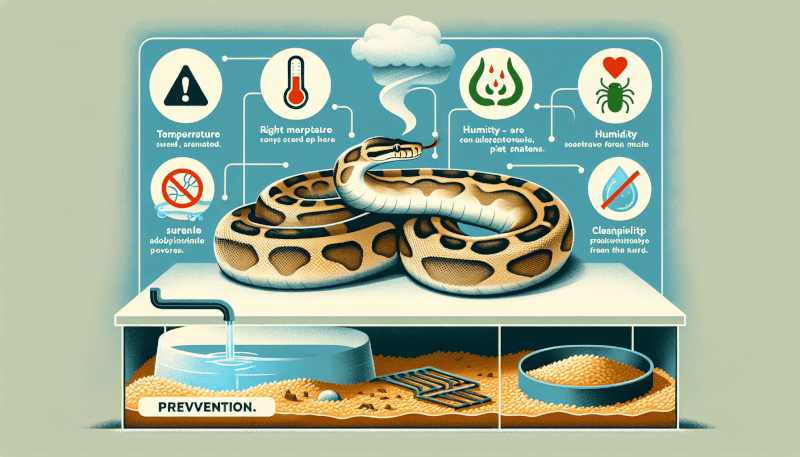If you’re the proud owner of a pet snake, then you know just how fascinating and unique these slithering companions can be. However, just like any other living creature, snakes can also experience respiratory issues that may require your attention. In this article, we’ll explore the top 10 ways you can prevent and treat respiratory issues in pet snakes, ensuring that your scaly friend stays healthy and happy. From proper habitat and temperature control to regular hygiene practices, these tips will equip you with the knowledge you need to keep your beloved snake in tip-top shape. So, let’s jump right in and discover how to give your snake the respiratory care it deserves!

Proper Enclosure Setup
Provide Adequate Ventilation
When setting up an enclosure for your pet snake, it is essential to provide adequate ventilation. Good airflow is crucial in maintaining a healthy environment for your snake. Proper ventilation helps regulate temperature, reduces humidity levels, and prevents the buildup of harmful gases. To ensure sufficient ventilation, it is beneficial to have multiple ventilation points in the enclosure, such as vents or mesh lids. This allows fresh air to circulate and prevent the accumulation of stagnant air.
Maintain Optimal Temperature and Humidity
Maintaining optimal temperature and humidity levels is vital for the well-being of your pet snake. Different snake species have specific temperature and humidity requirements, so it’s crucial to research and understand the needs of your particular snake. Providing a temperature gradient within the enclosure allows your snake to regulate its body temperature effectively. Additionally, a hygrometer can help monitor and maintain proper humidity levels, ensuring your snake’s respiratory system remains healthy.
Avoid Drafts
Snakes are sensitive to drafts, which can cause respiratory issues. Drafts can be caused by open windows, doors, or air conditioning units. It is important to place your snake’s enclosure away from sources of drafts and to ensure there are no gaps or cracks where cold air can enter. Drafts can lead to temperature fluctuations and make it difficult for your snake to maintain the optimal body temperature. By providing a draft-free environment, you can reduce the chances of respiratory problems in your pet snake.
Avoid Excessive Dust
Excessive dust in the enclosure can irritate your snake’s respiratory system. When choosing substrates and cleaning the enclosure, it is crucial to avoid materials that produce or attract dust. Cedar and pine shavings, for example, are known to release aromatic compounds that can be harmful to snakes. Instead, opt for dust-free substrates such as reptile carpet, paper towels, or newspaper. Regularly cleaning and removing any debris or dust buildup from the enclosure will help maintain a clean and healthy environment for your snake.
Regularly Clean and Disinfect the Enclosure
Maintaining a clean enclosure is essential for preventing respiratory issues in pet snakes. Regular cleaning and disinfecting help remove any bacteria, parasites, or other pathogens that can lead to illness. Be sure to use reptile-safe cleaning products and follow the manufacturer’s instructions. It is important to thoroughly clean and disinfect all surfaces, including hiding spots, water bowls, and any decor or furnishings. By regularly cleaning the enclosure, you can provide a hygienic living space for your snake and minimize the risk of respiratory infections.
Appropriate Substrate
Avoid Using Cedar or Pine Shavings
Choosing the right substrate for your snake’s enclosure is crucial for their respiratory health. Cedar and pine shavings, commonly used as bedding, can release harmful aromatic compounds that can irritate your snake’s respiratory system. These compounds can cause respiratory issues and may even be toxic to snakes. It is best to avoid using cedar or pine shavings as substrate and opt for safer alternatives like reptile carpet, paper towels, or newspaper.
Choose Dust-Free Substrates
Dust-free substrates are essential in preventing respiratory issues in pet snakes. Some substrates, such as certain types of sand or wood shavings, can produce fine particles that can be inhaled by your snake. These particles can irritate the respiratory system and lead to respiratory problems. Choosing dust-free substrates, such as reptile carpet or paper-based bedding, ensures a clean and healthy living environment for your snake.
Proper Substrate Depth
Maintaining the proper substrate depth is important for your snake’s comfort and respiratory health. Snakes like to burrow and hide, and having the appropriate depth of substrate allows them to exhibit natural behaviors. The ideal substrate depth depends on the size and species of your snake. Generally, a depth of one to two inches is sufficient for most snakes. It is important to regularly monitor the substrate depth and make adjustments as necessary to ensure a comfortable and safe environment for your pet snake.

Healthy Diet
Provide a Balanced and Nutritious Diet
A healthy and balanced diet is crucial for preventing respiratory issues in pet snakes. Snakes are carnivorous and have specific dietary requirements. It is important to feed your snake a varied diet that includes a range of suitable prey items. Feeding a balanced diet ensures that your snake receives all the essential nutrients it needs to maintain a healthy immune system and respiratory system. Consult with a reptile veterinarian or snake expert to determine the proper diet for your specific snake species.
Avoid Feeding Live Prey
Feeding live prey to your snake can pose significant risks to their respiratory health. Live prey can fight back, injure your snake, and introduce bacteria or parasites into the enclosure. Additionally, the movement of live prey can generate stress in snakes, which can weaken their immune system and make them more susceptible to respiratory issues. It is recommended to feed pre-killed or frozen-thawed prey items to ensure the safety and well-being of your pet snake.
Monitor Feeding Behaviors
Regularly monitoring your snake’s feeding behaviors is important to detect any potential respiratory issues. Loss of appetite, regurgitation, or difficulty swallowing can be signs of underlying respiratory problems. If you notice any changes in your snake’s feeding patterns, it is essential to consult with a reptile veterinarian. Prompt veterinary care can help identify and address any respiratory issues before they worsen.
Proper Handling Techniques
Wash Hands Before and After Handling
Proper hand hygiene is crucial when handling your pet snake. Before handling your snake, it is important to wash your hands thoroughly with soap and warm water. This helps remove any potential contaminants or bacteria that may be present on your hands. After handling your snake, it is equally important to wash your hands again to prevent the transfer of any pathogens from your snake to yourself or vice versa.
Avoid Overhandling
Overhandling can cause stress and respiratory issues in pet snakes. Snakes are solitary animals and prefer to have limited interaction with humans. Too much handling can disrupt their natural behaviors and lead to stress-related health problems. It is important to give your snake plenty of time to rest and minimize handling to essential activities such as cleaning the enclosure or veterinary check-ups. By avoiding overhandling, you can help prevent unnecessary stress and respiratory issues in your snake.
Gentle Handling to Prevent Stress
When handling your snake, it is important to use gentle and appropriate techniques to prevent stress and respiratory problems. Handling should be done with slow, smooth movements to avoid startling or frightening the snake. Supporting the snake’s body and providing a secure grip helps them feel safe and reduces the risk of the snake struggling or becoming anxious. By practicing gentle and stress-free handling, you can help maintain your snake’s respiratory health and overall well-being.

Regular Veterinary Check-ups
Choose a Reptile Veterinarian
Regular veterinary check-ups are essential for maintaining your pet snake’s respiratory health. It is important to choose a veterinarian who specializes in reptiles or has experience with snakes. Reptile veterinarians have the knowledge and expertise to identify and address any potential respiratory issues in snakes. They can also provide guidance on proper care, diet, and enclosure setup to prevent respiratory problems.
Schedule Regular Check-ups
Scheduling regular check-ups with a reptile veterinarian is crucial in preventing and detecting respiratory issues in pet snakes. Routine examinations allow the veterinarian to assess your snake’s overall health, including their respiratory system. During these check-ups, the veterinarian will listen to the snake’s breathing, check for any signs of respiratory distress, and provide any necessary vaccinations or deworming treatments. Regular veterinary check-ups help ensure early detection and intervention in case of any respiratory issues.
Follow Vaccination and Deworming Protocols
Following vaccination and deworming protocols recommended by your reptile veterinarian is essential for preventing respiratory issues in pet snakes. Vaccinations protect against certain diseases that can cause respiratory problems, while deworming treatments help prevent parasitic infections that can affect the respiratory system. It is important to stay up-to-date with these preventive measures to provide the best possible protection for your snake’s respiratory health.
Quarantine New Snakes
Isolate New Snakes for Observation
When introducing a new snake to your collection, it is crucial to isolate them for an observation period. Quarantining new snakes helps prevent the spread of potential diseases to existing snakes in your collection and allows you to monitor the new snake for any signs of illness, including respiratory issues. During the quarantine period, keep the new snake in a separate enclosure, ideally in a different room. This isolation period provides an opportunity to assess the snake’s health and ensure it does not pose any risk to other snakes.
Thoroughly Clean and Disinfect Quarantine Enclosure
The quarantine enclosure should be thoroughly cleaned and disinfected before housing a new snake. This helps eliminate any potential pathogens or parasites that may be present from previous occupants. Use reptile-safe cleaning products and follow the manufacturer’s instructions to ensure proper disinfection. Vigilant cleaning and disinfecting during the quarantine period can help minimize the risk of introducing respiratory issues or other health problems to your existing snake collection.
Monitor for Signs of Illness During Quarantine Period
During the quarantine period, it is essential to closely monitor the new snake for any signs of illness, including respiratory issues. Watch for symptoms such as coughing, wheezing, difficulty breathing, or nasal discharge. If you observe any concerning signs, consult with a reptile veterinarian immediately. Early detection and prompt treatment can prevent the spread of illness and ensure the new snake receives appropriate care for any respiratory issues.

Minimize Stress
Provide Adequate Hiding Places
Adequate hiding places in the enclosure are essential for minimizing stress and promoting good respiratory health in pet snakes. Snakes are naturally solitary creatures that require seclusion and privacy. Providing multiple hiding spots, such as caves or branches, allows your snake to feel secure and reduces their stress levels. By creating a calm and stress-free environment, you can help prevent respiratory issues and promote overall well-being in your pet snake.
Maintain a Quiet and Calm Environment
Maintaining a quiet and calm environment is essential for the respiratory health of pet snakes. Loud noises, excessive vibrations, or sudden disruptions can cause stress and anxiety in snakes. Stress can weaken the immune system and make snakes more susceptible to respiratory issues and other health problems. It is important to keep the snake’s enclosure in a peaceful area of your home, away from high-traffic areas or noisy appliances, to minimize stress and promote respiratory health.
Avoid Sudden Changes in Routine or Environment
Snakes are sensitive to sudden changes in their routine or environment, which can lead to stress and respiratory issues. Avoid making abrupt changes to the enclosure setup, temperature, or lighting. Introduce any changes gradually, allowing your snake time to adjust. Sudden changes can trigger stress responses, weaken the immune system, and increase the risk of respiratory problems. By maintaining a consistent and stable environment, you can help keep your snake’s respiratory system healthy.
Maintain Clean Air Quality
Avoid Smoking Near Snakes
Smoking near snakes can have detrimental effects on their respiratory health. Secondhand smoke contains harmful chemicals and irritants that can be inhaled by your snake, leading to respiratory issues. It is crucial to avoid smoking around your pet snake or in the same room as their enclosure. By keeping the air free from smoke and other pollutants, you can help maintain clean air quality and promote the respiratory health of your snake.
Use Air Purifiers or Filters
Using air purifiers or filters can help improve the air quality in your snake’s environment. These devices can remove dust, allergens, and other airborne particles that can contribute to respiratory issues. Choose an air purifier or filter that is appropriate for the size of your snake’s enclosure and regularly maintain and clean the device as recommended by the manufacturer. By incorporating air purifiers or filters into the enclosure setup, you can provide cleaner air and reduce the risk of respiratory problems in your pet snake.
Regularly Ventilate the Room
Proper ventilation of the room where your snake’s enclosure is located is essential for maintaining clean air quality. Adequate airflow helps prevent the buildup of stagnant air and removes any potential pollutants or respiratory irritants. Open windows or use fans to promote air circulation in the room. However, it is important to ensure that drafts are avoided, as mentioned earlier, to prevent temperature fluctuations. By regularly ventilating the room, you can help maintain a fresh and clean environment for your pet snake.

Recognize Early Signs of Respiratory Issues
Monitor Breathing Patterns
Regularly monitoring your snake’s breathing patterns is crucial for recognizing early signs of respiratory issues. Normal breathing in snakes is smooth and quiet, with no audible wheezing or difficulty exhaling. Any changes in breathing patterns, such as rapid or labored breathing, warrant further investigation and potential veterinary care. By actively observing your snake’s breathing, you can quickly identify any abnormalities and seek prompt veterinary attention.
Observe for Coughing, Wheezing, or Mouth Breathing
Coughing, wheezing, or mouth breathing are all signs of potential respiratory issues in pet snakes. If you notice your snake making repeated audible coughing sounds, wheezing or gasping for breath, or excessively opening and closing their mouth, it is essential to consult with a reptile veterinarian. These symptoms may indicate respiratory distress or infection and should not be ignored. Early intervention and appropriate treatment can improve your snake’s respiratory health and prevent the condition from worsening.
Watch for Nasal or Ocular Discharge
The presence of nasal or ocular discharge in pet snakes can be indicative of respiratory problems. If you notice any fluid or mucus coming from your snake’s nose or eyes, it is important to seek veterinary care. Nasal or ocular discharge can be a sign of infection or inflammation in the respiratory system, and prompt diagnosis and treatment are necessary. By remaining vigilant and observing any discharge, you can ensure your snake receives the necessary care for respiratory issues.
Seek Veterinary Care Promptly
Don’t Delay Seeking Professional Help
If you suspect or observe any respiratory issues in your pet snake, it is crucial not to delay seeking professional veterinary help. Respiratory problems can worsen rapidly in snakes, and early intervention is critical for a successful outcome. Contact a reptile veterinarian with experience in snake respiratory health to schedule an examination as soon as possible. Timely veterinary care can prevent the condition from progressing and ensure your snake receives appropriate treatment.
Follow the Veterinarian’s Instructions
Following the instructions and recommendations provided by your reptile veterinarian is vital for the successful treatment of respiratory issues in pet snakes. The veterinarian may prescribe medication, recommend changes to the enclosure setup or diet, or advise on supportive care measures. It is important to carefully follow their instructions, administer medications as prescribed, and make any necessary modifications to your snake’s care routine. By actively participating in your snake’s treatment plan, you can optimize their chances of recovery and respiratory health.
Administer Medications as Prescribed
If your snake requires medication for respiratory issues, it is essential to administer the medications as prescribed by your reptile veterinarian. Follow the veterinarian’s instructions regarding dosage, frequency, and administration method. Some medications may need to be given orally, while others may be applied topically or through injections. It is important to handle your snake gently and ensure they are comfortable during the medication administration process. By diligently administering medications, you can help expedite your snake’s recovery and alleviate respiratory symptoms.
In conclusion, proper enclosure setup, appropriate substrate, a healthy diet, proper handling techniques, regular veterinary check-ups, quarantine for new snakes, stress minimization, clean air quality, early recognition of respiratory issues, and prompt veterinary care are all essential for preventing and treating respiratory issues in pet snakes. By following these guidelines, you can provide a safe and comfortable environment for your snake, reduce the risk of respiratory problems, and ensure their overall well-being. Remember to always consult with a reptile veterinarian for specific advice and recommendations tailored to your pet snake’s individual needs.


